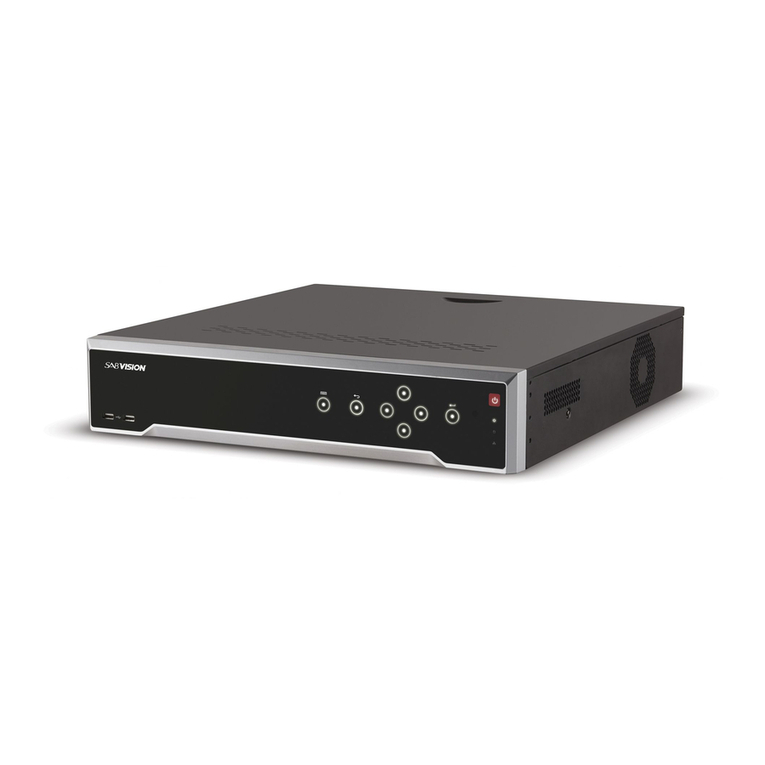8 9
12 13 14
1110
15
The maximum number of 4 playback video channels have been
reached, please deselect other channels rst to continue.
Note
Note
This product supports 32-bit IE8 or later versions and does not
support 64-bit IE browsers. It also supports Apple Safari and
Mozilla Firefox browsers.
8.1 Network Conguration 8.3 Access to the NVR in WAN
Now you can access to your NVR using the DDNS address, such as
https://domain name:HTTPS port.
As an example: https://a6747.mynvr.org:443
Click Add New...
If there is a UPnP function in your router.
Choose “Forwarding > UPnP”, make sure that the Current UPnP
Status is Enabled.
If UPnP has been enabled in the router, you do not need to perform
the following steps.
If UPnP is disabled, you need to select one of the following methods
to congure port forwarding on your router.
For these steps, we will be using the TP-LINK brand wireless router as
an example.
If there is no UPnP function in your router:
You need to manually add port forwarding, refer to the following
steps. You need go to the “Forwarding > Virtual Servers” panel for
setup.
You can also access the NVR or IP Camera directly through the local
network and remotely via manual port forwarding.
Click Save
Check DDNS
Check Enable DDNS
4. Repeat the Step3 to add multiple IP Cameras. Find your IP Camera in
the IP Camera List, then click the Finish button to complete the
setup wizard.
After the IP Camera is added successfully to the NVR, there are two ways
to enable manual recording functionality when in the Live View mode.
Method 1
Left click the mouse in the channel, and some buttons will pop up as
shown .
You can see the recording information, include Manual Record, Alarm
Record, Schedule Record.
1. Right click the mouse in the Live View mode, and a shortcut menu
will pop up.
2. Select the Playback to enter the Playback page.
3. Select the time and Video Type of the recording. Check the Channels,
and you can check up to four channels.
4. Click the Search button. Then you can see the recording video in the
Playback page.
Method 2
1. Right click the mouse in the Live View mode, and a shortcut menu
will pop up.
2. Select the Manual Record to enter the Manual Record page.
3. Check the channels for which you want to enable recording. Click the
OK button.
4. Then click the icon to exit the interface. In the Live View mode, the icon is at the bottom right of the screen
for each channel, indicating recording is on going.
1. Congure network information.
Right click the mouse in the Live View mode, choose “Menu >
Settings > Network”. Check the Network checkbox, then congure
the network information of the NVR.
It is highly recommended to set the port range from 5000 to 65535,
and the value of the port for each device should be unique.
2. Congure the DDNS.
Right click the mouse in the Live View mode, choose “Menu > Settings
> Network”. Check the DDNS checkbox. Enable DDNS on the NVR. We
recommend you to use the DDNS by default.
The live view interface will show you the video feed of each IP Camera.
Select the Type
Check Network
Set the HTTP Port or HTTPS Port
IP Address: Set it to an IP address of
NVR in the range of the router
address pool, or keep it as default.
Subnet Mask: Keep it as default.
Gateway: Should be the same as the
Router’s IP address.
DNS Server: Should be the same as
the router’s DNS Server address.
Check UPNP Click Save
8.2 Access to the NVR in LAN
Open the ”Equipment Search Tool” in the resource CD. It will display
information of the NVR on your LAN.
Double click the NVR in the list, and your default browser will open up
to the login page.
You can access to the NVR via the browser in LAN.
6
Manual Recording
7
Playback
8Remote Access
Click the button to enable recording.
To disable recording, click again the button in the channel, or
uncheck the channel checkbox on the Manual Record interface.
Note
Input the port and IP address
of your NVR and click Save.
443
443
7. Click OK
3. Select the Channel
5. Input the Username and
Password of the IP Camera.
4. Enusre that the IP address of the
IP Camera and NVR is on the same
network IP segment, and that the
subnet mask and gateway are the
same as the NVR's.
Click Finish
6. Select the protocol.




















